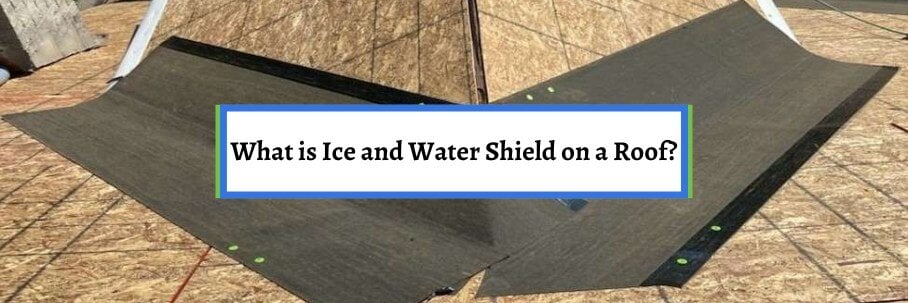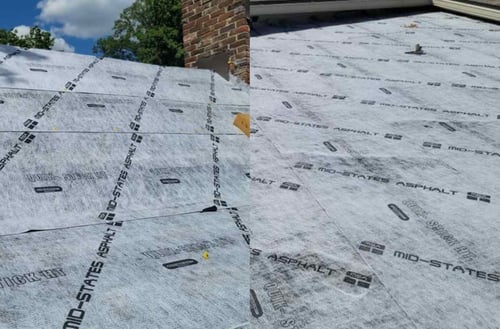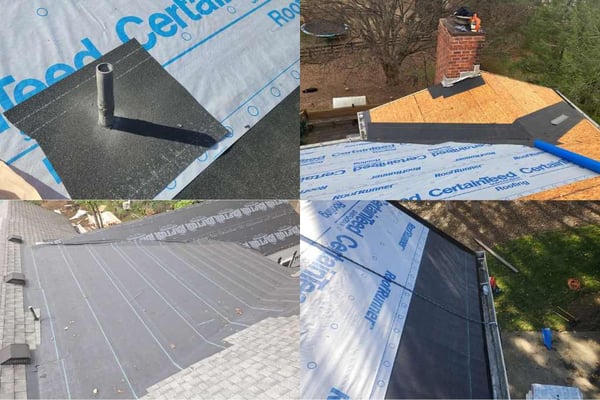What is Ice and Water Shield on a Roof?

Are you starting or about to start a new roofing project? Do you keep hearing about ice and water shield?
Ice and water shield is a crucial roofing component that every roof should have in certain places. Unfortunately, it’s also one of the most commonly left off to make prices cheaper.
This is just asking for costly repairs on leaks down the road. However, knowing what ice and shield is and where it goes gives you the power to ensure it’s included in your roof replacement.
For over 30 years, Bill Ragan Roofing has helped homeowners understand the importance of every roofing component. So, let’s look at everything you need to know about ice and water shield.
This article answers the following questions:
- What is ice and water shield for roofing?
- Where does ice and water shield go on a roof?
- Can you install ice and water shield on the entire roof?
- How much does ice and water shield cost?
What is ice and water shield for roofing?
Ice and water shield is a waterproof membrane used to reinforce vulnerable roof areas prone to leaks. This ensures your roof decking is protected if water gets underneath the roofing material (asphalt shingles, metal roof, etc.).
There are three types of ice and water shield: granular, smooth, and high heat.
.png?width=500&height=435&name=IceandWaterShieldinValley%20(2).png) (Granular ice and water shield)
(Granular ice and water shield)
Granular (also called sand surface) ice and water shield is the cheapest of the three types. It’s typically used in roof valleys and is the thinnest of the three types.
 (Smooth ice and water shield)
(Smooth ice and water shield)
Smooth surface ice and water shield is more flexible than granular, which is why it’s commonly used on low slope roofs and in areas that need a better seal.
 (High heat ice and water shield)
(High heat ice and water shield)
High heat ice and water shield is made of cotton-like fibers and is the most expensive of the three types. It’s primarily used on metal roofs because the cotton-like material won't stick to the panels as they expand and contract.
However, it’s also used with premium roof systems and in areas with high heat exposure for added extra protection.
Where does ice and water shield go on a roof?
Ice and water shield should be installed around penetrations, in roof valleys, against walls, and on roofs with a 2/12, 3/12, or 4/12 pitch. Penetrations and walls already have flashing, but installing ice and water shield in these areas provides even more protection if water gets under the flashing.

Roof valleys see a lot of water flowing through them, so they need increased protection just in case. However, a huge reason for installing ice and water shield in roof valleys is ice damming.
This will prevent leaks from water backing up valleys when snow and ice above the dam start to melt. There’s also an ice damming code in areas of the US above the snowline that requires two rows of ice and water shield along your roof’s rakes and eaves (roof edges).
.jpg?width=600&height=508&name=IceandWaterShieldUpgrade%20(2).jpg)
So, you’ll have to pay for rows of ice and water shield along your roof’s edges if your area has a code. When it comes to roof pitch, any roof facet below a 4:12 will most likely have ice and water shield.
This is simply because there’s not enough of an angle for water to drain fully. Installing ice and water shield in these areas provides increased protection if sitting water gets under the roofing material.
Can you install ice and water shield on the entire roof?
Yes, you can install ice and water shield on an entire roof. Not only is it very expensive, but synthetic underlayment does the job just fine.
So, installing ice and water shield on an entire roof is really only necessary in certain situations. A common reason is if the roof or an individual facet is below a certain pitch for increased protection if the angle won’t allow water to drain down your roof all the way.
 (High heat ice and water shield over entire roof before metal roof installation)
(High heat ice and water shield over entire roof before metal roof installation)
On the other hand, metal roofing should have high heat ice and water shield installed over the entire roof as the underlayment. Remember, the fibers ensure the material won't stick to the panels as they expand and contract.
You’ll also see premium materials (cedar shake, synthetic shingles, etc.) get high heat ice and water shield over the entire roof. However, this is something to talk to your roofing contractor about.
How much does ice and water shield cost?
It’s impossible to give you an exact cost number for ice and water shield. The price of roofing materials fluctuates constantly and heavily depends on the area.
However, I can give you a general idea of how much it adds to the cost of your new roof based on the type. Granular ice and water shield starts around $60.00 per row of material (3 feet by 33 feet) required.
Smooth ice and water shield costs around $100.00 per square (100 square feet of roof area) to start, but can quickly cost more based on the brand and labor costs. High heat ice and water shield is the most expensive, costing around $125.00 or more per square.
These numbers above aren’t exact, and what you’ll pay heavily depends on how much is needed, the roofing contractor you hire, and local pricing. However, this does give you an idea of how much adding ice and water shield to your roof costs.
What other components and materials make up a roof?
Now you know what ice and water shield is, where it’s installed, and an idea of the cost. It's a crucial roofing material that every roof needs in the specific areas I mentioned.
However, it’s just one important piece. A roof is actually a system made up of different components and materials that fit together to prevent water from getting into your home.
If one is missing, you’ll be looking at costly roof leaks. Unfortunately, there are too many stories of bad roofers leaving things off to make their prices cheaper.
Trust me, this is the last thing you want. So, I want to help you understand all the materials and components that must be included with your roof replacement.
Check out 9 Materials Included With Your Roof Replacement to learn the crucial components you’ll be paying for when replacing your roof.


